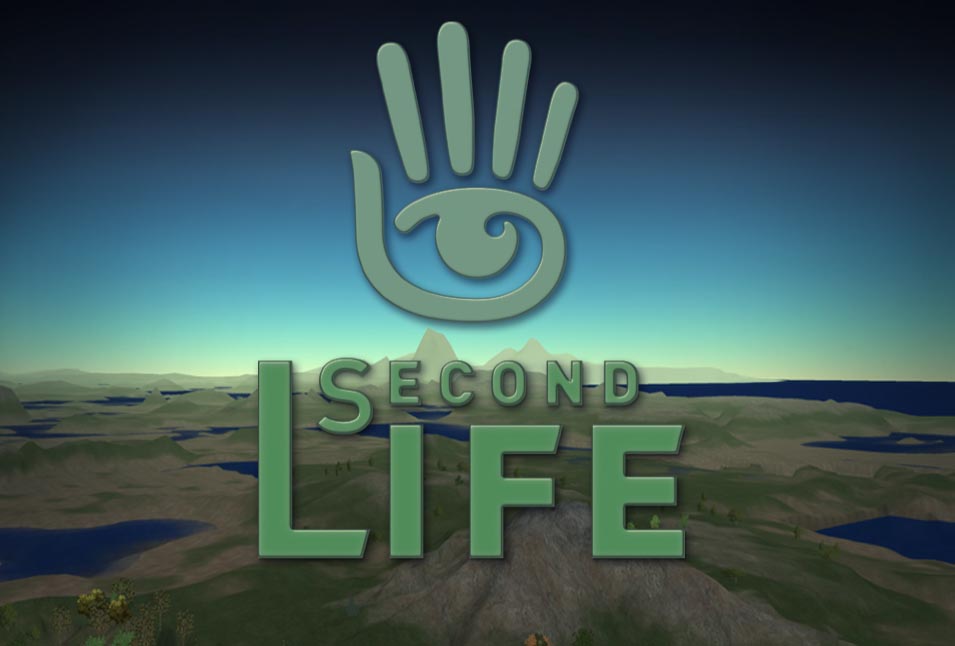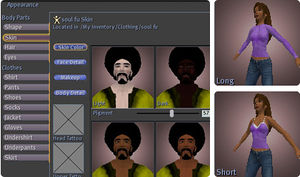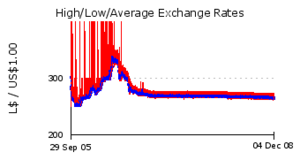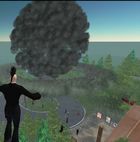CPSC203 2008Fall T19 Group2
Contents
Second Life: A Virtual Reality
Team Members:
Amarjit
Kevin
Herman
Gabrielle
Jasmine
Introduction
Second Life (abbreviated as SL) is an Internet-based virtual world developed by Linden Labs and launched on 23 June 2003. A free downloadable client program called the Second Life Viewer enables its users, called "Residents", to interact with each other through motional avatars, providing an advanced level of a social network service combined with general aspects of a metaverse. Residents can explore, meet other residents, socialize, participate in individual and group activities, and create and trade items (virtual property) and services with one another, while traveling freely throughout the game world (the grid). Organizations such as IBM, Stanford University, NASA, and the American Cancer Society operate presences on the Second Life Grid that seamlessly integrate their virtual world activities with their real-world operations. Virtual worlds could also transform the way businesses operate by providing a new template for getting work done, from training and collaboration to product design and marketing. Second Life caters for users aged over 18, while its sister site Teen Second Life is restricted to users aged between 13 and 18. Since opening to the public in 2003, it has grown explosively and today is inhabited by millions of Residents from around the globe.
Initial Project Statement
Second Life is a journey into a place in cyberspace where thousands of people lead imaginary lives. Internet gaming is becoming increasingly more advanced and popular; allowing gamers to consume themselves in the virtual world. Users could possibly be confronted with legal issues and moral affliction once they are negativity influenced by their misconception between reality and virtual reality.
History
The Creator
Second Life is a virtual game where people are able to experience multiple interactions amongst different avatars and diverse environments. Users may also explore and create their imaginations in this virtual game. Second Life had originated from Philip Rosedale, whom founded Linden Lab in 1999. 38 year old Philip Rosedale had realized that he had a dream of building a virtual-reality environment, so he had quit his job as a chief technology officer at Real Networks.
Rosedale's Vision
Philip Rosedale had initially developed a hardware that would let computer users to be fully immersed in a 360 degree virtual world. The company first had used several computer monitors that users could wear on their shoulders to imitate a 360 degree effect. Soon, that idea became a software application Linden World. Linden World was a software where computer users could interact in socialization and games in a 3D online environment. This later on became known as Second Life.
Creativity Involvement of Users
In 2001, Philip Rosedale noticed that participants were more responsive to the creative potential of the game. Philip Rosedale had decided to set the playing system of Second Life to a more user created environment. Many of Second Life's components and world has been created by the players of the game.
How It Works
Avatars
As a resident in Second Life, each individual user is required to create an avatar, a character made by the user in the virtual world. Because avatars are created by the users, the users have the abilities to customize their avatar with special features or they can simply design an avatar which has a similar resemblance to the user themselves. The design created for the avatar is not permanent and therefore the user can change its appearance to take as many different forms as the resident would like. Within this virtually created society, residents are able to find individuals with whom they share similar interest for socialize through the usage of avatars. Residents are able to stay in touch with each other through the usage of chat and instant messaging. Chat programs are used as a form of public communication whereas instant messaging is used for personal conversations.
Production of Good and Services
Second Life allows all of its resident’s access to build anything that they be fond of with tools provided by the website. Residents are inspired to build whatever they have a desire for and encouraged to do so through trouble-free software that is easy to follow, and through tutorials which provide step by step lessons as to how to create objects. Through the use of scripting language, an internal event-driven language, residents are able to further improve their creations by allowing them to add behaviors to objects which they build. Residents are able to build virtual objects, which under the Terms of Service of Second Life guarantees that users preserve copyright to anything that they create. However, if they do wish to do so, users are allowed to sell or give away their content
The Economy
Second Life contains a private economy, detached from the real world, where residents have the ability to make real money. Since residents are able to create their own goods and services, they can, if they wish to do so, sell their creations for money. Because Second Life has its own market, it also contains its own virtual money known as Linden dollars. Linden dollars are bought and sold at LindeX exchange. Like the real world, Second Life releases stats on the flow of Linden dollars throughout their economy. This virtual economy inspires many of its users to create their own products and distribute them in hopes of making money and contributing to the 3D world.
Teen Second Life
Since its launch in 2003, Second Life has grown rapidly and is used by many people throughout the world. As an approach to provide safer content for children who use Second Life, Linden Lab created Teen Second Life, a version of Second Life intended for teenagers within the age group of 13-17. Teen Second Life combines elements of videogame and chat programs which allow teenagers within the restricted age group to socialize and customize their own 3D version of a virtual world. Linden Lab has guaranteed users that teenagers using the site will not be exposed to adult content, which can be viewed on Second Life.
Application of Second Life
Second Life is used by many educational facilities such as universities and colleges in various subjects such as chemistry and English. Second Life is used in 300 Colleges and Universities. Second Life has also become the home of virtual meeting places for various religious organizations. Second Life has allowed online sites to advance by providing their users with a creative toolset. As a result, as the number of users who participate in this second world increase, so does their knowledge of computers
Issues Game Arrises
When it comes to Second Life, the misconception between reality and virtual reality is one of the issues which prevails to be the most apparent when it comes to online gaming. While gaming, people seem to forget that they are in a virtual world and seem to get caught up in the moment. Because of this, many people forgot to distinguish the difference between what is wrong and what is right. The overflow of imagination from gaming on Second Life influences peoples judgment to the extent where many begin to question the influence of virtual reality and reality.
Virtual Reality vs. Reality
Online gaming becomes a problem when you consume yourself in the virtual world so much that it becomes reality itself. To add to that, it does not help with corporations and companies promote their real life products into the game. Some of these companies include TELUS, American Apparel, Reebok, Toyota, and much more. Though Second Life would act as a great medium for Corporations to advertise or promote their products, users are victims when they are hypnotized by virtual reality; living their reality through online gaming. This is quite obvious when a thanksgiving parade was launched by Macy’s both in real life and in Second life.
One major issue with socializing through virtual reality is that there is no face to face human interaction, thus, you do not really know who’s sitting behind that computer screen. This leads many to think about questions such as:
- Is this user actually who they say they are or are they lying?
- Are they actually a male or female?
- Are they really as old as they say they are, or are they a child predator?
- Is the depth of my involvement with virtual reality affecting my personal life, education, family and friends
Real life Divorce over online game
In early November this year, a couple ended their marriage when 28 year old Amy Taylor from London England, caught her husband having virtual sex with another woman in Second Life. Taylor’s suspicions led her to hiring an online detective to determine whether or not her real life husband David Pollard, 40, was having virtual relations with another woman. Whether this is considered cheating, acting inappropriately or maybe it’s just fooling around; it’s evident that virtual reality has detrimental effects to reality. Amy Taylor is now in another relationship with another man she found on the game World of Warcraft.
Child Pornography
Although the user may be an adult, sexually related activity involving avatars with a child-like appearance has occurred on Second Life and has cause quite a stir. Avatars can range in a wide selection when it comes to appearance. This means that it is possible to have a child like avatar. Second Life is an adult based virtual world, which allows it users to “have” intercourse with on another. As a result, characters can have sex with a child like avatar. However, the opposite may exist as well, where the avatar is creating children and providing contents of child pornography online. It is more than obvious that people seem to forget what is the right thing to do, even when they are in a virtual world, and let themselves do things which would not normally be done in the real world. life and animated creations. Also, because it is actually possible for the avatars in Second Life to have intercourse, pornography has also had a negative impact on second life. Second Life has been an accomplice to pedophiles using the service to create or exchange child pornography which could contain both "real sex" or animae sex.
Violence
People with different view and beliefs tend not to get along with each other. In the game Second Life, players resort to violence in order to boost their beliefs. The supporters of the Spanish socialist and conservative parties have been trying to burn down each others’ offices in Second Life. Acts of violence such as throwing bombs, entering the building with sub-machine guns, lit fires, have been committed between these two opposing parties. These virtual demonstrations may encourage users to commit these actions in reality.
Gambling
Online gambling services are not offered on Linden Lab and Second life. Currently online gambling is illegal in the US, players online must follow the state and federal law applicable to regulated online gambling. This applies even if both players and operators are located outside of the US.
Education through Second Life
The popularity and technology of Second Life is growing at rapid rates which allows companies use it as an effective tool to channel their products to users, in addition post-secondary professors are also using it was a means to educate their students.
Major disadvantages of educating students online include:
- Student’s exposures to distractive surroundings
- Students not taking their work seriously
- Attendance of students (distracted students; they may be online but they are not in class)
- Absence of a face to face interaction with instructor
- Not able Analyzing and managing student behaviour
Teaching through second life online does have its advantages, however throughout the years education through the face to face classroom settings has been proven effective, like they say, “if it ain’t broke, don’t fix it”
Conclusion
As gaming evolves, people seem to lose their sense of what is reality and what is not reality. The virtual world of Second Life has proven that statement. Users of Second Life have become so involved in their virtual world that elements of reality seem to fade. In the “real world”, people are able to distinguish from what is morally correct or wrong, but this is not the same when it comes to Second Life. People allow their imaginations to consume their reality in a manner that their actions and behavior in Second Life are reflected in real-life.
Resources
Amarjit
1. http://www.youtube.com/watch?v=memW5zjGyFs
2. http://computer.howstuffworks.com/second-life-job.htm
3. http://www.wisegeek.com/what-is-second-life.htm
4. http://www.secondlife-art.com/
5. http://weburbanist.com/2007/06/17/top-3-look-alike-avatars-and-people-from-second-life-to-real-life/
6. http://teen.secondlife.com/
7. http://lindenlab.com/pressroom/news
8. http://www.secondlifempire.com/money
9. http://teen.secondlife.com/parents
10. http://teen.secondlife.com/features
Kevin
1. http://mrmetaverse.com/index.html
2. http://www.mixedrealities.com/?p=566
3. http://www.time.com/time/specials/2007/time100/article/0,28804,1595326_1615737_1615877,00.html
4. http://www.inc.com/magazine/20070201/hidi-rosedale.html
5. http://blog.secondlife.com/2007/07/25/wagering-in-second-life-new-policy/
7. http://www.unconfirmedsources.com/?itemid=2867
8. http://www.youtube.com/watch?v=0t1XR-LrgyM
9. http://www.hobbyspace.com/nucleus/HSblog.php?blogid=2&archive=2006-12
10. http://www.pcpro.co.uk/news/113543/virtual-political-violence-strikes-second-life.html
11. http://en.wikipedia.org/wiki/Second_Life
Herman
1.http://www.time.com/time/magazine/article/0,9171,1651500,00.html
3. http://www.cnn.com/2008/WORLD/europe/11/14/second.life.divorce/index.html
4. http://www.secondlifeherald.com/
5. http://www.tomshardware.com/news/sun-life,3609.html
6. http://www.time.com/time/magazine/article/0,9171,1651500,00.html
8. http://foo.secondlifeherald.com/slh/2008/11/macys-thanksgiv.html#more
9. http://www.darcynorman.net/2006/11/15/i-dont-get-second-life/
Gabrielle
2.http://www.cnn.com/2008/WORLD/europe/11/14/second.life.divorce/index.html
3.http://secondlife.com/whatis/
4.http://www.businessweek.com/magazine/content/06_18/b3982001.htm
5.http://www.time.com/time/magazine/article/0,9171,1570708,00.html
6.http://www.slideshare.net/efsym/virtual-world-watch-summary-of-second-life-snapshots-presentation/
8.https://jira.secondlife.com/browse/WEB
9.http://www.press.jhu.edu/books/title_pages/2728.html
10.http://communities.cilip.org.uk/files/folders/umbrella/entry3327.aspx










